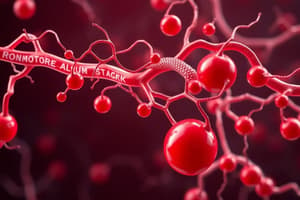Podcast
Questions and Answers
What is the primary role of erythropoietin in erythropoiesis?
What is the primary role of erythropoietin in erythropoiesis?
- To promote iron mobilization from the liver
- To stimulate the production of reticulocytes (correct)
- To enhance the contraction of bone marrow
- To inhibit the development of erythroid progenitor cells
Which transcription factors are important for regulating erythropoiesis?
Which transcription factors are important for regulating erythropoiesis?
- NF-kB and AP-1
- LIF and SOX2
- GATA and KLF (correct)
- MYC and Rb
Where does the process of erythropoiesis primarily occur during embryonic development?
Where does the process of erythropoiesis primarily occur during embryonic development?
- In the fetal liver and later in the bone marrow (correct)
- In the yolk sac, then in the liver, and finally in the spleen
- Directly in the bloodstream from stem cells
- In the bone marrow throughout the entire embryonic phase
What is the effect of hepcidin in the regulation of erythropoiesis?
What is the effect of hepcidin in the regulation of erythropoiesis?
What is the final stage of erythropoiesis before red blood cells enter the bloodstream?
What is the final stage of erythropoiesis before red blood cells enter the bloodstream?
What is the primary function of TFR1 in relation to iron?
What is the primary function of TFR1 in relation to iron?
How does HIF2α influence hepcidin expression during low iron levels?
How does HIF2α influence hepcidin expression during low iron levels?
What role do GDF15 and TWSG1 play in iron metabolism?
What role do GDF15 and TWSG1 play in iron metabolism?
What happens to the expression of TFR1 when cellular iron levels are low?
What happens to the expression of TFR1 when cellular iron levels are low?
What is the typical saturation range of transferrin in healthy humans?
What is the typical saturation range of transferrin in healthy humans?
Flashcards are hidden until you start studying
Study Notes
Erythropoiesis Overview
- Erythropoiesis is the process of red blood cell (RBC) production, involving stages from yolk sac to fetal liver and ultimately bone marrow.
- Erythropoietin (EPO) synthesized in the kidneys stimulates erythropoiesis.
- Hepcidin, produced in the liver, inhibits iron mobilization, a critical factor for erythropoiesis.
- Transcription factors like GATA and KLF play crucial roles in regulating different stages of erythropoiesis.
Iron Regulation in Erythropoiesis
- Transferrin (Tf) transports iron in the bloodstream, with typical saturation levels between 20% and 45%.
- Transferrin receptor 1 (TFR1) on the cell membrane facilitates iron uptake.
- IRE/IRP system regulates TFR1 expression, ensuring adequate iron absorption when needed.
- Low iron triggers IRP binding to IRE in the 3′ UTR of TfR1 mRNA, stabilizing and promoting its translation, leading to increased TFR1 expression.
Transcription Factors in Erythropoiesis
- GATA transcription factors are crucial for hematopoiesis, with GATA-1 essential for RBC progenitor cell development and differentiation.
- GATA-2 regulates the survival and proliferation of hematopoietic stem and progenitor cells.
- KLF1 is abundant in erythroid cells, activating gene transcription and promoting early RBC differentiation.
- KLF1 plays a role in the final stages of the cell cycle and chromatin condensation, facilitating efficient RBC production.
- Mutations in GATA1 and KLF1 are associated with different types of anemia.
Reduced Erythropoiesis
- Myelodysplastic syndrome (MDS) is a group of clonal diseases characterized by hematopoietic stem cell abnormalities, leading to decreased erythropoiesis.
- Many MDS patients have somatic mutations in spliceosome genes, with SF3B1 being the most frequent.
- Aplastic anemia (AA) is caused by hematopoietic stem cell abnormalities and can be treated with hematopoietic stem cell transplantation or immunosuppressive therapy.
- Chronic disease anemia (ACD), also known as inflammatory anemia (AI), is often driven by hepcidin, an inflammatory cytokine that restricts iron availability for erythropoiesis.
- Iron transfer from macrophages to developing erythroid cells requires transferrin and FPN.
- Selenium deficiency can lead to reduced erythroid cell number and differentiation, impacting erythropoiesis.
Studying That Suits You
Use AI to generate personalized quizzes and flashcards to suit your learning preferences.




